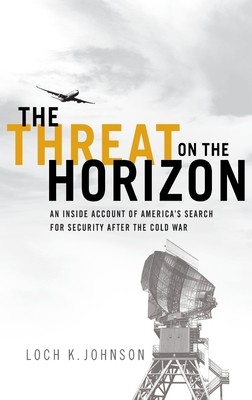
- We will send in 10–14 business days.
- Author: Loch K Johnson
- Publisher: Oxford University Press, USA
- ISBN-10: 0199737177
- ISBN-13: 9780199737178
- Format: 16.3 x 24.1 x 4.2 cm, kieti viršeliai
- Language: English
- SAVE -10% with code: EXTRA
Reviews
Description
The Aspin-Brown Commission of 1995-1996, led by former U.S. Defense Secretaries Les Aspin and Harold Brown, was a landmark inquiry into the activities of America's secret agencies. The purpose of the commission was to help the Central Intelligence Agency and other organizations in the U.S. intelligence community adapt to the quite different world that had emerged after the end of the Cold War in 1991.
In The Threat on the Horizon, eminent national security scholar Loch K. Johnson, who served as Aspin's assistant, offers a comprehensive insider's account of this inquiry. Based on a close sifting of government documents and media reports, interviews with participants, and, above all, his own eyewitness impressions, Johnson's thorough history offers a unique window onto why the terrorist attacks of 2001 caught the United States by surprise and why the intelligence community failed again in 2002 when it predicted that Iraq possessed weapons of mass destruction. It will be the first published account by an insider of a presidential commission on intelligence--a companion volume to Johnson's acclaimed study of the Church Committee investigation into intelligence in 1975 (A Season of Inquiry). This examination of the Aspin-Brown Commission is an invaluable source for anyone interested in the how the intelligence agencies of the world's most powerful nation struggled to confront newglobal threats that followed the collapse of the Soviet empire, and why Washington, D.C. was unprepared for the calamities that would soon arise.
EXTRA 10 % discount with code: EXTRA
The promotion ends in 21d.20:29:50
The discount code is valid when purchasing from 10 €. Discounts do not stack.
- Author: Loch K Johnson
- Publisher: Oxford University Press, USA
- ISBN-10: 0199737177
- ISBN-13: 9780199737178
- Format: 16.3 x 24.1 x 4.2 cm, kieti viršeliai
- Language: English English
The Aspin-Brown Commission of 1995-1996, led by former U.S. Defense Secretaries Les Aspin and Harold Brown, was a landmark inquiry into the activities of America's secret agencies. The purpose of the commission was to help the Central Intelligence Agency and other organizations in the U.S. intelligence community adapt to the quite different world that had emerged after the end of the Cold War in 1991.
In The Threat on the Horizon, eminent national security scholar Loch K. Johnson, who served as Aspin's assistant, offers a comprehensive insider's account of this inquiry. Based on a close sifting of government documents and media reports, interviews with participants, and, above all, his own eyewitness impressions, Johnson's thorough history offers a unique window onto why the terrorist attacks of 2001 caught the United States by surprise and why the intelligence community failed again in 2002 when it predicted that Iraq possessed weapons of mass destruction. It will be the first published account by an insider of a presidential commission on intelligence--a companion volume to Johnson's acclaimed study of the Church Committee investigation into intelligence in 1975 (A Season of Inquiry). This examination of the Aspin-Brown Commission is an invaluable source for anyone interested in the how the intelligence agencies of the world's most powerful nation struggled to confront newglobal threats that followed the collapse of the Soviet empire, and why Washington, D.C. was unprepared for the calamities that would soon arise.


Reviews